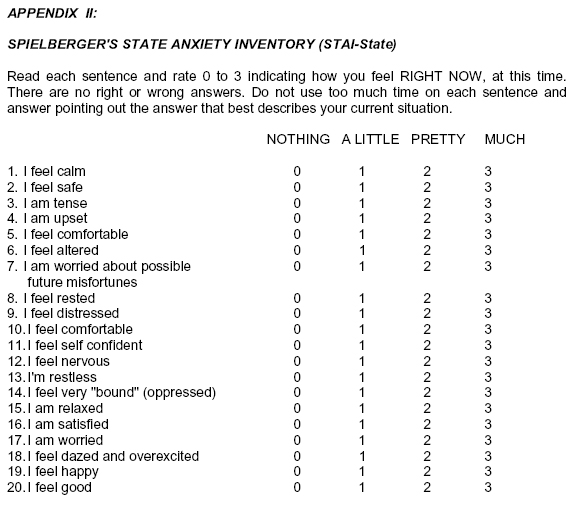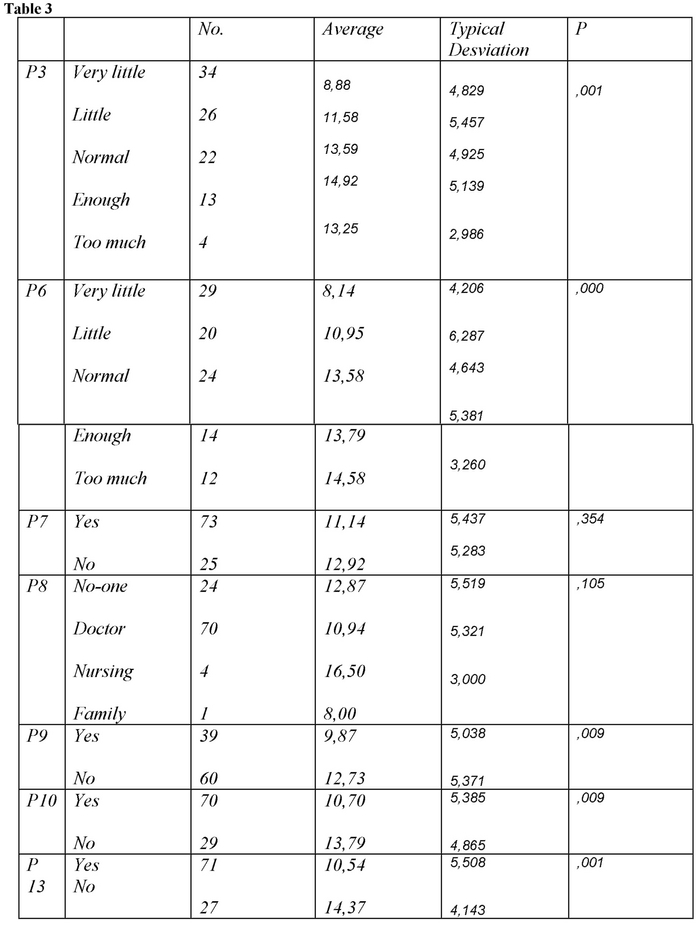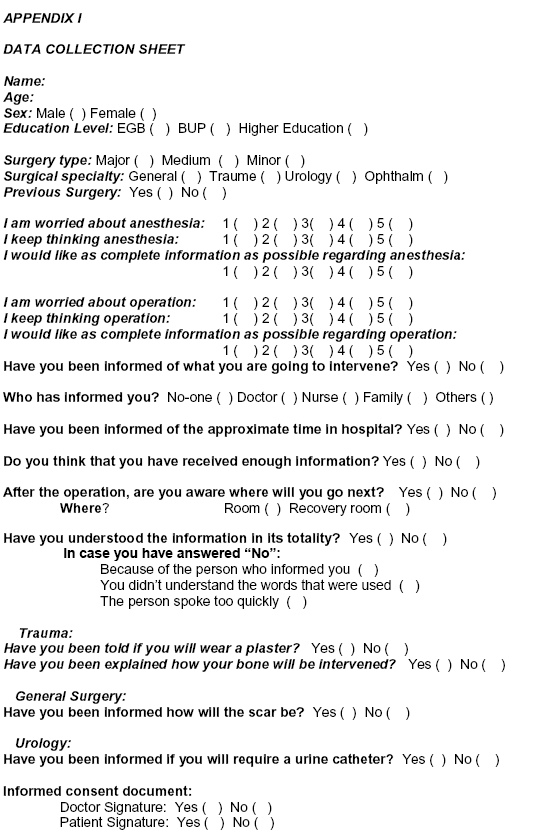My SciELO
Services on Demand
Journal
Article
Indicators
-
 Cited by SciELO
Cited by SciELO -
 Access statistics
Access statistics
Related links
-
 Cited by Google
Cited by Google -
 Similars in
SciELO
Similars in
SciELO -
 Similars in Google
Similars in Google
Share
Enfermería Global
On-line version ISSN 1695-6141
Enferm. glob. vol.14 n.37 Murcia Jan. 2015
DOCENCIA-INVESTIGACIÓN
Preoperative aspects of information related to patient anxiety scheduled for surgery
Aspectos de la información preoperatoria relacionada con la ansiedad del paciente programado para cirugía
Doñate Marín, M.*; Litago Cortés, A.**; Monge Sanz, Y.*** and Martínez Serrano, R.****
*Nursing. Hospital Universitario Royo Villanova. E-mail: mariadm 10@hotmail.com
**Physician. MFY specialist. Servicio de Urgencias Hospital Universitario Miguel Servet
***Physician. MFY specialist. Centro de Salud Torrero-La Paz
****Nursing. Hospital Universitario Miguel Servet. Zaragoza. Spain
ABSTRACT
Background: Preoperative anxiety is a frequent event that depends on multiple factors. One is the prior information to the patient, which must be simple, understandable and reliable. The aim of this study is to establish the relationship between the degree of information of the surgical procedure and the level of preoperative anxiety in patients scheduled for surgery.
Material and methods: Cross-sectional study of 99 randomly selected patients scheduled for surgery at the Hospital Royo Villanova (sector I at Zaragoza). APAIS and STAI-AE scales were used to assess the preoperative anxiety level and the degree of prior information. The statistical analysis was performed using SPSS v.21.0, with the Chi-square test, ANOVA test and the nonparametric Kruskal Wallis to study the association between the different questions and the degree of anxiety. To assess the association of the two scales Pearson correlation test was used.
Results: The educational level, type of surgery, previous surgery, specialty and previous surgery variables do not show statistical significance (p <0.05) compared to the anxiety level variable. It has been shown that there is an association between the degree of information and level of anxiety.
Conclusions: The data shown in the present study support the hypothesis that patients who believe they need more knowledge about the surgical procedure have higher anxiety levels than patients who believe they need less.
Key words: Anxiety; anxiety disorder; degree of information; surgical procedure; pre-anesthesia; preoperative.
RESUMEN
Introducción: La ansiedad preoperatoria es un evento frecuente que depende de múltiples factores. Uno de ellos es la información previa que recibe el paciente, que debe de ser sencilla, inteligible y fidedigna. El objetivo de este estudio es establecer la relación entre el grado de información del procedimiento quirúrgico y el nivel de ansiedad preoperatoria en los pacientes programados para cirugía.
Material y métodos: Estudio descriptivo transversal de 99 pacientes seleccionados aleatoriamente, programados para intervención quirúrgica en el Hospital Royo Villanova, del sector I de Zaragoza. Se valoró el nivel de ansiedad preoperatoria y el grado de información previa mediante la escala APAIS y se utilizó la escala STAI-AE en algunos de los pacientes, para comprobar la veracidad de la escala APAIS. El análisis estadístico se realizó mediante el programa SPSS v.21.0, aplicando la prueba de Chi-cuadrado, el test Anova y la prueba no paramétrica de Kruskal Wallis para estudiar la asociación entre las distintas preguntas y el grado de ansiedad. Para valorar la asociación de las dos escalas se empleó el test de Correlación de Pearson.
Resultados: Las variables de: nivel educativo, tipo de cirugía, especialidad e intervención quirúrgica previa, no muestran una significación estadística (p<0,05) respecto a la variable de nivel de ansiedad. Se ha evidenciado que existe asociación entre el grado de información y el nivel de ansiedad.
Conclusiones: Los datos que muestra el presente estudio refuerzan la hipótesis de que los pacientes que creen necesitar más conocimientos sobre el procedimiento quirúrgico presentan niveles de ansiedad mayores que los pacientes que creen necesitar menos.
Palabras clave: Ansiedad; Trastorno de ansiedad; Grado de información; Procedimiento quirúrgico; Preanestesia; Prequirúrgica.
Introduction
Anxiety is defined as the state of (soft or intense) uneasiness often caused from the unknown or nonspecific for the individual1. Anxiety may have an adaptive function but nevertheless it can produce an illness if it is out of proportion.
Patients undergo high levels of anxiety when they are waiting just before a surgical procedure, anxiety depends on several factors such as sex, age, socio-economic setting, occupation, surgery... 3,4 If useful information about the patient's current health, possible illness and the subsequent treatment is not provided by the team who attend the patient, levels of anxiety will increase5.
Written information does not excuse verbal information; they complement each other, and its content needs to be adapted to the clinic situation. Information must be clear, understandable and reliable. It should not be exhaustive but it has to avoid misunderstandings and help the patient understand the pursued medical objective and proposed procedures.
The content of the information is frequently a matter that leads to discussion; however, it should include the following elements6-11: schematic statement of the planned procedure, proposed anesthetic technique and its simplified description, pre-anesthetic methods for fasting, pre-anesthetic eventual medication, methods for post-anesthetic surveillance, detailed previous information about pre-transfusion and methods of postoperative analgesia.
Opinion surveys which analyzed the patient's expectations regarding the content and amount of information about anesthesia have shown the difficulties of the problems. The degree of the demand for information is highly variable depending on the patient 12,13. In general, patients who demand more information are more anxious.
The issues that most concern patients are those referred to the anesthetic technique, complications of anesthesia and surgery, postoperative pain and nausea and vomiting. Other concerns are related to personal fears. However, excessive detailed information may reassure some patients, but also raise new fears in others14. There is controversy about whether the previous information benefits all patients, since there is a clear discrepancy between the various studies on the usefulness to provide information before surgery 1,15-17 .
Most studies focus on the 24 hours previous to surgery. In our case, the study was carried out in the moments before surgery when the patient is already in the living host/ pre-operation room (30 minutes before surgery), so that we can measure the patients' levels of preoperative anxiety in a more realistic way.
The hypothesis of this study is that the level of anxiety experienced by patients in a host of surgical block is lower in patients who receive preoperative good information than in those who do not.
The aim of the study is to establish the relationship between the degree of preoperative information and the anxiety level of patients, analyzing both variables individually and the association between them.
Material and methods
Observational and cross-sectional descriptive study carried out between December 2012 and February 2013, at Royo Villanova Hospital, sector I in Zaragoza.
A consecutive non-probability sampling was made selecting patients according the following inclusion criteria: patients aged between 55 and 93 who were about undergoing a process of elective surgery scheduled, including the specialties of ophthalmology, urology, orthopedics and general surgery, with the previous signed informed consent. Patients who did not sign the informed consent, who had a history of cognitive disorder or who were undergoing an emergency surgery were excluded.
Once the informed consent is signed, nurses performed the questionnaire, which includes the APAIS scale, to the entire population subject to be studied during the "host" in the surgery block. Some randomly selected patients were provided with the STAI -AE scale to verify the accuracy of the APAIS scale regarding anxiety, as it is not validated in Spain. The initial questionnaire consists of three parts: socio-demographic aspects and signed informed consent for the procedure, APAIS scale and some closed questions that have been considered interesting for the study (annex 1).

Statistical analysis was performed using SPSS version 21.0. Quantitative variables are presented as the average using the standard deviation of the average as the way of measurement, while qualitative variables are expressed as a percentage.
In order to determine the significance of the observed differences in anxiety levels of the various variables studied, the Chi- square test was applied. . To study the association between the questionnaire and the anxiety level, both the Anova test and the nonparametric Kruskal-Wallis test were applied, while the Pearson correlation test was used to assess the association of the two scales.
We will work in all cases with a significance level of 95% (p < 0.05)
Results
Out of the 99 patients, 48 were males (48.5%) and 51 females (51.5%) with an average age of 70.59 years and a range of 55 to 93. 77.8 % of the patients have a basic education level, 13.1 % medium level and 9.1 % high level. Regarding the surgical specialties, 31.3 % were Traumatology, 30.3 % to General Surgery, Urology 22.2 %, to 16.2% and to Ophthalmology. Major surgery was performed in 48.5 % of cases, medium surgery in 37.4 % and 14.1% minor surgery. For 11.1% of patients it was first surgery.
100 % of patients who are undergoing surgery for the first time have anxiety, 85.2 % (p> 0.05) from the group of patients who have previously undergone a surgical procedure, this result is no statistically significant probably due to the insufficient sample size.
Regarding the closed questions provided in the third part of the questionnaire, 70.7 % of patients stated that the information provided was sufficient, and 71.7 % claimed a total understanding of such information. As for the items that individually assess the different aspects of information were observed regarding the quality and quantity as perceived by the patient (table 1).
Using the APAIS scale (anxiety-information) the average score for the item anxiety was 11.61, and with regards to the need for information received before entering the theatre was 4.86. When patients feel they need more information, 76.6% had anxiety (p = 0.014) (table 2) (graph 1).
Information scale (APAIS) results
The analysis of anxiety levels against sex and educational level did not show any statistically relevant results (p>0.05).
The two scales used report that the anxiety of the evaluated patients is average. The Pearson correlation test was applied to compare the results in each survey and the correlation results did not indicate significant results (p=0.274), most likely due to the simple size.
Statistically relevant results were found between the patient's anxiety levels and several aspects of the provided information, such as the amount of information about the anesthesia and the surgical intervention, the estimated hospital stay, whether the patient considers that they have received enough information and the understanding of the information.

Discussion
The results obtained in this study suggest that the patients that believe to need more information about the surgical process present with higher anxiety levels than those from patients that require less information.
With regards to the degree of information, it was found that patients that needed more information about the surgical process presented with higher anxiety levels.
There is controversy in scientific literature on this topic, as some authors describe how a larger stress could be inflicted on patients as they might feel stressed about receiving too much information or information they did not want to receive in the first place. Some studies support the results presented in this article, such as the results described by Carrascosa, where an improvement in the knowledge of the surgical intervention via a structured nurse-led pre-operative interview is correlated with lower anxiety levels than those observed in patients that did not receive this intervention. Other studies, such as the results obtained by Marin Romero et al (2004) who studied the anxiety levels of patients undergoing knee surgery, do not confirm the hypothesis that a nurse-led intervention to provide information to surgical patients greatly decreases the anxiety in the process of care.
Any person that is admitted in a hospital presents with anxiety, mainly due to the fact of having an illness or disease, but even more so, when the purpose of the admission is to undergo a surgical procedure. At times this can even generate a life-threatening feeling and hence any healthcare organization should review, plan, oversee, update and modify the pathways by which a patient arrives to a clinic, is admitted for a hospital stay and/or theatres, so that his/her anxiety levels are minimized during their hospital stay, with th highest possible amount of information.
Conclusions
The validation of this hypothesis will represent an important step for the prevention of pre-operatory anxiety, as it will allow identifying the associated risk factors that can b modified. Also, bearing in mind that the implementation of the informed consent mandatory for all healthcare professionals, we should be aware of the extent information that patients receive so that the right measures can be put in place, such a in the first place, to help the post-operatory recovery and the patient satisfaction level secondly reducing the cost of health care and free assets (beds) more efficiently, with consequent increase in the number of patients who can be treated
Received: November 1, 2013
Accepted: 11 January 2014
References
1. Marín Romero, I., Martínez Gómez, P., Ponsich Pubill, J., Pubill Grasa, M Ansiedad en pacientes intervenidos de rodilla. Enfermería Global na4 Mayo 2004 página 1. [ Links ]
2. Barrero Garcés, C. y Camacho Assef, V. Ansiedad prequirúrgica en niños. Artículo publicado en la revista del hospital Provincial Docente del Dr. Antonio Luaces Iraola. Acceso: 28 Diciembre de 2011. [ Links ]
3. Williams, O.A. Patient knowledge of operative care. JR SOC. Med. 1993;86:328-331. [ Links ]
4. Ruiz López, E., Muñoz Cuevas, J.H., Olivero Vásquez, Y.I., Islas Saucillo, M. Ansiedad preoperatoria en el hospital General de Mexico. Rev médica del hospital general. Vol 63, n.4.Oct-dic. 2000: 231-236. [ Links ]
5. A. San José, R. San José, B. Zuza, F. Zunzarren, T. Luri. Aspectos de la información preoperatoria al paciente en la cirugía de urgencia. Navarra. [ Links ]
6. Bugge K, Bertelsen F, Bendtsen A. Patients' desire for information about anaesthesia: Danish attitudes. Acta Anaesthesiol Scand 1998; 42: 91-96. [ Links ]
7. Farmer RD, Lawrenson RA. Oral contraceeptives and venous thromboembolic disease: the findings from database studies in the United Kingdom and Germany. Am J Obstet Gynecol 1998; 179 (suppl): 578-586. [ Links ]
8. Hutchinson GL, Lonsdale M. Patient's desire for information about anaesthesia: Australian attitudes (Correspondence). Anaesthesia 1993; 48: 645-646. [ Links ]
9. Watkins, E.J., Milligan, L.J., O'Beirne, H.A. Information and consent for anesthesia. Journal of the Association of Anaesthetists of Great Britain and Ireland, London 2001, vol 56 879-881. [ Links ]
10. Macario A, Weinger M, Carney S, Kim A. Wich clinical anestesia outcomes are important to avoid? The perspective of patients. Anesthesia and Analgesia. 1999; 89:652-658. [ Links ]
11. Otteni, J.C., Desmonts, J.M., Haberer, J.P. Recommandations françaises et étrangères sur la pratique de l'anesthésie-réanimation. Volume 20, Issue 6, June 2001, Pages 537-548. [ Links ]
12. Moerman N, van Dam FS, Muller MJ, Oosting H. The Ámsterdam preoperative anxiety and information scale (APAIS). Anesth Analg 1996;82:445-451. [ Links ]
13. Wisiak UV, Kroll W, List W. Communication during the preoperative visit. Eur J Anaesthesiol 1991;8:65-68. [ Links ]
14. Elsass P, Eikard B, Junge J, Lyrke J, Staun P, Feldt-Rasmussen M. Psychological effects of detailed preanaesthetic information. Acta Anaesthesiol Scand 1987; 31: 579-583. [ Links ]
15. Kiyohara, LY., et al. Surgery information reduces anxiety in the pre-operative period. Rev. Hosp Clin Fac Med Sao Paulo. 2004 Apr. 59 (2): 51-56. [ Links ]
16. Alfidi, R. Informed consent: a study of patient reaction. JAMA 1971; 216: 1325-1329. [ Links ]
17. Elsass, P. et al. Pyichological effect of detailed pre-anesthetic information. Acta Anaesthesiol. Scand. 1987; 31:579-583. [ Links ]
18. Carrascosa, M.T., Aguilar, R., Carrascosa, M.C. Disminución de ansiedad en paciente quirúrgico mediante una intervención de enseñanza individual. Asociación Española de Enfermería en Urología. 2011;118:13-17. [ Links ]
19. Chirveches, E., et al. Efecto de una visita prequirúrgica de enfermería perioperaoria sobre la ansiedad y el dolor. Enferm. Clin. 2006;16(1):3-10. [ Links ]











 text in
text in 






